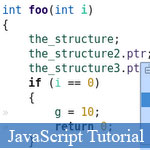









 Cette guides article JavaScript tutoriel vous explique comment v?rifier le type des variables JavaScript Ce guide contient JavaScript tutorial complet achev? codes JavaScript par exemple et les commentaires , il est tr?s facile ? suivre , s'il vous pla?t aller ? la page compl?te de la poste pour plus de d?tails
Cette guides article JavaScript tutoriel vous explique comment v?rifier le type des variables JavaScript Ce guide contient JavaScript tutorial complet achev? codes JavaScript par exemple et les commentaires , il est tr?s facile ? suivre , s'il vous pla?t aller ? la page compl?te de la poste pour plus de d?tails
JavaScript POO Tutorial pour les nuls
? 10 extraits de code JavaScript Tiny pour les d?butants bonne
? Top 10 Meilleurs livres JavaScript que les d?butants devraient apprendre
? Les bases de Javascript pour les d?butants
The secret to our solution lies in how JavaScript handles undefined variables versus undefined properties. Here’s a quick reminder on the difference between the two:
// variable foo
var foo;
// property bar (and object variable foo)
var foo = {}; // create an empty object to add bar too
foo.bar = "";
The difference between these makes all the difference whether a fatal error occurs:
foo; // ReferenceError: foo is not defined
var foo = {};
foo.bar; // undefined
foo.blah; // undefined
We can randomly invent and check any property of foo we want, and the code will keep chugging along:
var foo = {};
foo.something = "hello";
if(foo.bar) { // undefined, interpreted as false (same as !!foo.bar)
// never runs
}
if(foo.something) {
foo.something; // "hello"
}
Now comes the magic. If you know anything about JavaScript running
in the browser, you know that all global variables are part of the window object. This means foo and window.foo are equivalent:
var foo; foo === window.foo; // true // "this" is another bag of worms, but note this anyway this.foo === window.foo;
So technically our variable foo is a property of the window object. So we should be able to check for any arbitrary variable in the window scope now!
window.foo; // undefined (not a fatal error!) // even though we're checking for the same thing, we get a fatal error… foo; // ReferenceError: foo is not defined
Now as long as we have a global entry point for our code, we can write our code in such a way that it won’t ever give us a fatal error if our variables aren’t yet defined:
if(window.foo && foo.bar) {
foo.bar();
}
Of course nothing happens, because we haven’t defined foo. But why
doesn’t foo.bar give us a fatal error? Because the first test, window.foo
failed out. It would be useless processing for the JavaScript engine
to also evaluate the second statement, because the end result will still
be the same (false && true results in false, false &&
false results in false). So it doesn’t get so far as foo.bar.
And now the code will work properly when we hook up our code to our foo global namespace:
var foo = {
bar: function() {
alert("hello world");
}
}
if(window.foo && foo.bar) {
foo.bar(); // "hello world"
}
It’s becoming common to see an abbreviation for the above code. Check out the following two methods, which accomplish the same thing:
// Method 1
if(window.foo && foo.bar) {
foo.bar(); // "hello world"
}
// Method 2
window.foo && foo.bar && (foo.bar());
Don’t get too scared.. these blocks of code are equivalent. Method 2
is shorter, but it simply goes something like this: if window.foo isn’t
set, stop evaluating this line (just as above in the if statement). Otherwise, if foo.bar exists then execute the code in parentheses, which gives us an alert (“hello world”);
Just a word of caution about using Method 2: it’s obviously less clear what’s going on here. Your own cleverness might actually result in unnecessary confusion, especially of other people work in the same code base and they’re at different levels of understanding. In these cases we should first strive to be clear, and then only clever if it’s not at the expense of being clear.
It’s also likely that a code minifier would take care of this cleverness for us at build time, giving us the best of both worlds.